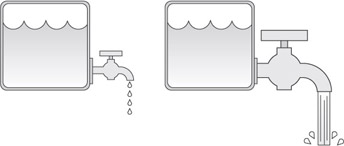Bandwidth and Bit Rate
In order for streaming to work properly, the player application must play the audio and video content at a steady and continuous rate. If the stream isn’t continuous, the picture and sound will either stop or play back unevenly. This uneven playback occurs when the content is streamed at a bit rate that is higher than the bandwidth of the network.
The amount of time needed to download the file is directly related to the size of the file, the available bandwidth of the network, and the speed of your modem or network interface card. Network bandwidth can be compared to a water pipe. If you connect to the Internet using a modem and telephone line, the size of your pipe is very narrow—only a limited quantity of data can get through in a given amount of time. If you think of a file as being like a tank of water, then you understand that a very large tank of water takes a long time to go through a small pipe. Similarly, a large file can take several minutes to download from the Internet, through your telephone line, and onto your computer’s hard disk, as shown in figure 1.1. Furthermore, if the files you download are large, such as a 60-minute video, you can quickly run out of hard disk space.

Figure 1.1: Downloading data is similar to water flowing through a pipe.
If bandwidth is the size of the pipe, then the bit rate is the amount of water—or data per second—that can travel through the pipe. Bit rate is most often measured in kilobits per second (Kbps). When preparing content for streaming over the Internet—a process called encoding—it is important to consider the amount of bandwidth that is available to the people who will be playing the stream, and then to select a bit rate that is appropriate for that bandwidth. For example, a person with a 28.8 modem can potentially receive 28,800 bits per second or 28.8 Kbps. But it’s much more likely that they will receive less.
Why? Network overhead.
Network overhead is the other traffic that is always present on a network, filling up part of the available pipe. So if you are connecting to the Internet over a modem with a connection speed of 28.8 Kbps, then expect to do no better than 20 Kbps, maybe less. Similarly, a 56-Kbps modem probably won’t deliver more than 33 Kbps, and so on.
The following table illustrates the different kinds of network connections that are available today and the maximum bandwidth associated with each.
| Connection | Bandwidth |
| Dial-up | 28.8 to 56 Kbps |
| ISDN | 64 to 128 Kbps |
| DSL or Cable | 128 to 768 Kbps |
| T-1 | 1.5 megabits per second (Mbps) |
| T-3 | 45 Mbps |
| DS-3 | 45 Mbps |
EAN: 2147483647
Pages: 258